Description
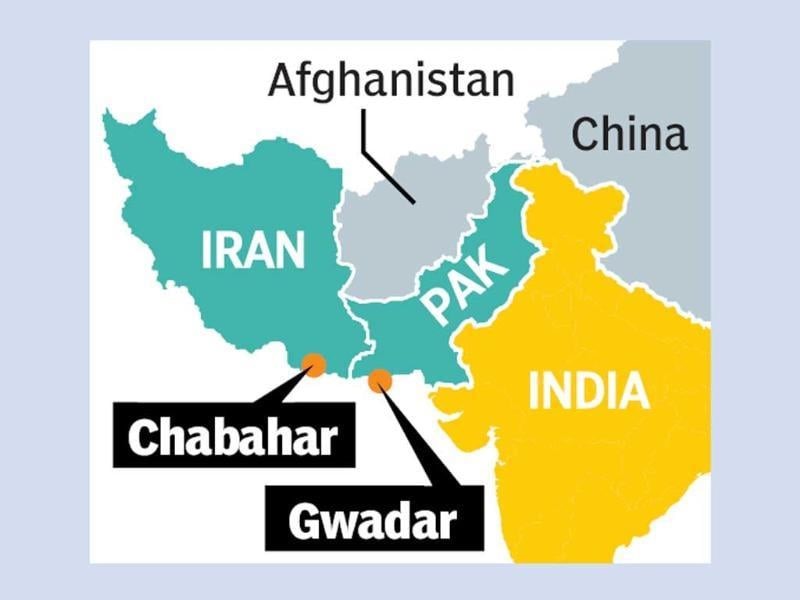
Disclaimer: Copyright infringement not intended.
Context
- India and Iran have agreed not to seek commercial foreign arbitration for disputes between users and operators at Chabahar Port, paving the way for the two sides to sign a long-term deal for the development of the strategic port.
Chabahar Port
- Chabahar Port is a seaport in Chabahar located in southeastern Iran, on the Gulf of Oman.
- It serves as Iran's only oceanic port, and consists of two separate ports named Shahid Kalantari and Shahid Beheshti.
- It is only about 170 kilometers west of the Pakistani port of Gwadar.
Location
- The port of Chabahar is located on the Makran coast of Sistan and Baluchistan Province, next to the Gulf of Oman and at the mouth of the Strait of Hormuz.
- It is the only Iranian port with direct access to the Indian Ocean. Being close to Afghanistan and the Central Asian countries of Turkmenistan, Uzbekistan, and others, it has been termed the "Golden Gate" to these landlocked countries.
- Chabahar is 700 km (430 mi) away from Zahedan, the capital of the Sistan and Baluchistan province.
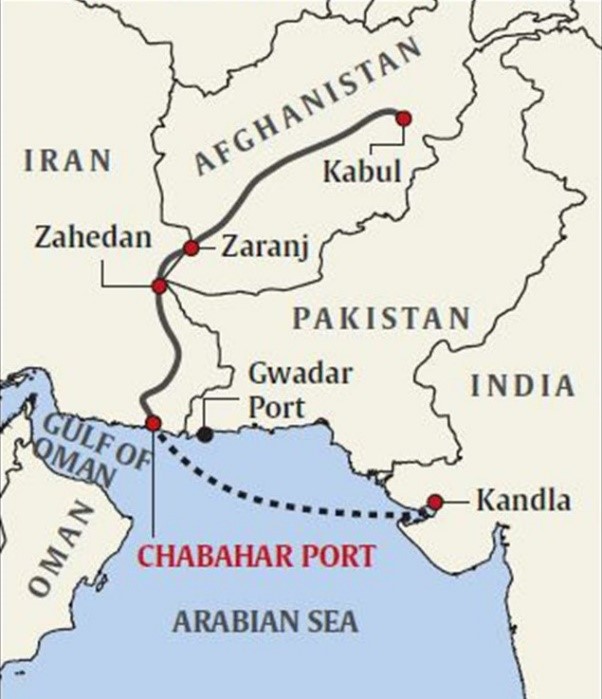
History
- Development of the port was first proposed in 1973 by the last Shah of Iran, though development was delayed by the 1979 Iranian Revolution.
- India and Iran first agreed to plans to further develop Shahid Beheshti port in 2003 but did not do so on account of sanctions against Iran.
Strategic importance
- Located on the edge of the Indian Ocean, it is the only deep-sea port in Iran with direct ocean access.
- Its geographic proximity to countries such as Afghanistan, Pakistan, and India, as well as its status as a key transit center on the burgeoning International North-South Transport Corridor, gives it the potential to develop into one of the most important commercial hubs in the region.
Recent Development
- In May 2016, Narendra Modi became the first Indian prime minister in 15 years to visit Iran, and during his visit, he pledged up to $500 million to develop and operate Iran's Chabahar port as part of a trilateral engagement between India, Iran and Afghanistan.
- Chabahar has two ports -- Shahid Kalantari and Shahid Beheshti -- each with five berths. The project investment arm of the shipping ministry -- India Ports Global -- is partnering with a joint venture between the Jawaharlal Nehru Port Trust and Gujarat's Kandla Port Trust to develop two container berths with a length of 640 metres and three multi-cargo berths by investing $85 million.
- Following the re-imposition of sanctions against Iran, foreign companies became reluctant to participate in the port's expansion.
- Sanctions also played a role in reducing India's involvement and investment in the US$1.6 billion Chabahar–Zahedan railway.
- In October 2017, India's first shipment of wheat to Afghanistan was sent through the Chabahar Port.
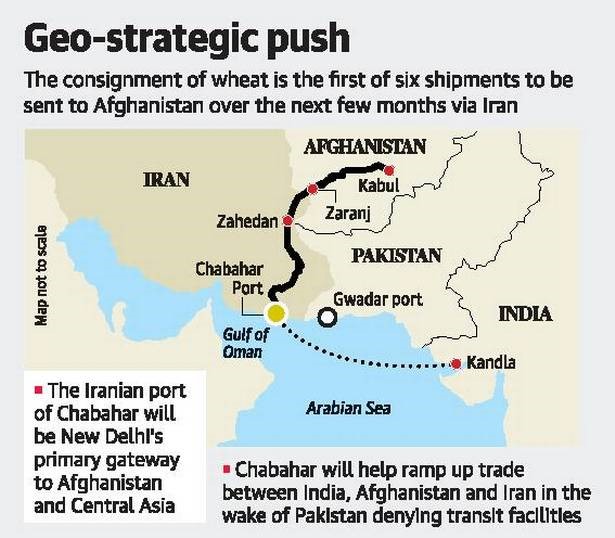
Reasons why Chabahar Port is crucial for India
- The first and foremost significance of the Chabahar port is the fact that India can bypass Pakistan in transporting goods to Afghanistan.
- Chabahar port will boost India's access to Iran, the key gateway to the International North-South Transport Corridor that has sea, rail and road routes between India, Russia, Iran, Europe and Central Asia.
- Chabahar port will be beneficial to India in countering Chinese presence in the Arabian Sea which China is trying to ensure by helping Pakistan develop the Gwadar port. Gwadar port is less than 400 km from Chabahar by road and 100 km by sea.
- With Chabahar port being developed and operated by India, Iran also becomes a military ally to India. Chabahar could be used in case China decides to flex its navy muscles by stationing ships in Gwadar port to reckon its upper hand in the Indian Ocean, Persian Gulf and Middle East.
- With Chabahar port becoming functional, there will be a significant boost in the import of iron ore, sugar and rice to India.
- The import cost of oil to India will also see a considerable decline. India has already increased its crude purchase from Iran since the West-imposed ban on Iran was lifted.
- Chabahar Port will ensure the establishment of a politically sustainable connectivity between India and Afghanistan. This is will, in turn, lead to better economic ties between the two countries.
- From a diplomatic perspective, Chabahar port could be used as a point from where humanitarian operations could be coordinated.
- The Zaranj-Delaram road constructed by India in 2009 can give access to Afghanistan's Garland Highway, setting up road access to four major cities in Afghanistan - Herat, Kandahar, Kabul and Mazar-e-Sharif.
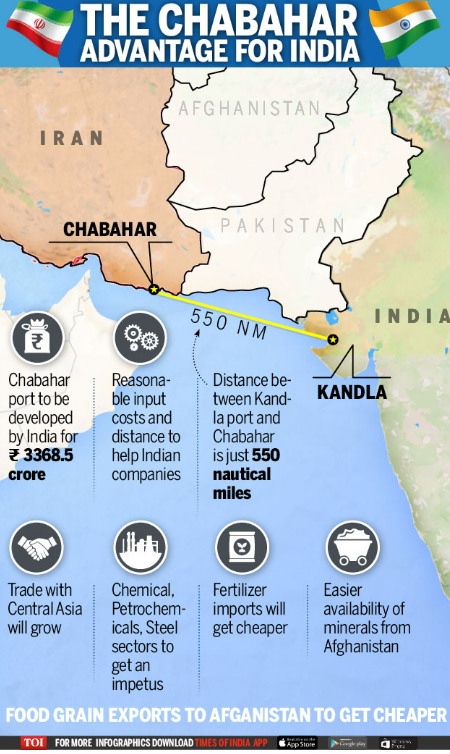
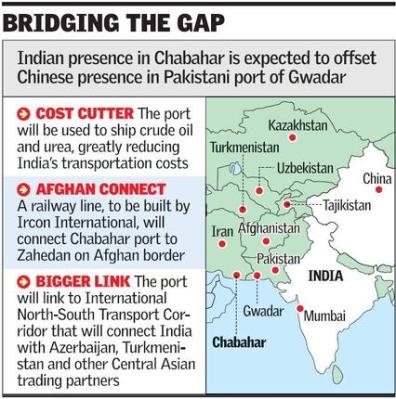
Chabahar: An arena for Geopolitical Competition
- India has served as the primary investor in Chabahar port, as New Delhi sees the port as a way to access Afghan and Central Asian markets without relying on Pakistan’s land routes.
- Furthermore, the port could strengthen Indo-Iranian ties, which could balance out growing Sino-Pakistani cooperation.
- At the same time, China has been growing increasingly influential in Iran, seeking to gain access to critical natural resources and shipping routes.
- Chabahar port has the capacity to transform trade in South and Central Asia. The proposed land-based trade routes linked to the port would facilitate greater access to the Afghan and Central Asian markets. The impact of this increased connectivity has enormous implications for Afghanistan in particular, although the fallout from the Taliban’s rapid takeover of the country could jeopardize these plans moving forward.
- Currently, Afghanistan conducts most of its trade via routes through Pakistan; Chabahar port could provide an alternative trade outlet for the country. In turn, Chabahar has the potential to generate massive economic growth in Afghanistan, as it would allow goods from other countries to more easily enter the country and bolster its export potential.
- As for the Central Asian countries, Chabahar would offer these landlocked countries access to sea-based trading routes and serve as a bulwark against Chinese and Russian attempts to dominate trade in the region. Therefore, expanded trade with Afghanistan and the Central Asian countries has the potential to bolster Iran’s own status on the international stage.
- Chabahar port represents a means of connecting not only with Afghanistan and Central Asia, but also with the global economic juggernauts of India and China.
- Given that Iran’s development budget for the port’s home province has skyrocketed by 2,200 percent since 2018, it’s clear that Chabahar will be an integral part of Iran’s eastern engagement strategy.
- Establishing a sea-based trade route to Western and Central Asia via Chabahar port would allow India to bypass Pakistan and establish trade networks with the countries in these regions.
- Concern: Chinese collaboration with Pakistan via the development of Gwadar port and the China-Pakistan Economic Corridor raised concerns over how the partnership of India’s two main adversaries could impact the country.
- A major catalyst for their renewed cooperation stemmed from Chinese President Xi Jinping’s 2013 announcement that China would commence its massive Belt and Road Initiative (BRI) infrastructure project.
- India’s involvement with Chabahar port, thus, serves as a key strategy for using the Indo-Iranian alliance to buffer China and particularly Sino-Pakistani cooperation.
- India is not the only superpower that has a stake in Chabahar port, as China has also sought to strengthen ties with Iran to secure energy and mineral resource reserves and gain access to advantageous Eurasian trade routes. Chinese access to Chabahar port would immensely benefit these objectives, as China could connect the port to its own extensive maritime-based trade network. Considering China’s investment in Pakistan’s Gwadar port, another key driver of China’s interest in Chabahar port would be to block India from accessing routes to Afghanistan and Central Asia.
- Analysts perceive the recently signed China-Iran 25-year cooperation program, in which China agreed to invest $400 billion into the Iranian economy in exchange for discounted and guaranteed energy prices and BRI project cooperation, as a way to gradually assert its presence in the port.
Iran’s Balancing Act
- The economic and diplomatic opportunities presented by India and China could help Iran bolster its own great power ambitions, but asymmetrical power sharing and trade deals could render Iran as a junior partner or glorified resource appendage. Therefore, Iran is trying to find ways to strategically balance India and
Recent moves by India and Iran
- In a significant diplomatic move, Indian Prime Minister Narendra Modi and Iranian President Ebrahim Raisi engaged in discussions to harness the complete potential of the Chabahar Port. [August 2023]
- The leaders deliberated on enhancing infrastructure, streamlining trade processes, and addressing logistical challenges to optimise the port's operations.
- The discussions underscored the joint commitment of India and Iran to regional development and cooperation. By leveraging Chabahar's capabilities, both nations aim to foster economic growth and stability in Afghanistan and beyond.

Closing Remarks
- The Chabahar Port project exemplifies the multi-dimensional potential of diplomacy, trade, and connectivity. It aligns with India's larger vision of the International North-South Transport Corridor (INSTC), which seeks to establish efficient trade routes linking the Indian Ocean to the Caspian Sea through various modes of transport.
- As geopolitical dynamics evolve, the collaboration between India and Iran over Chabahar Port reinforces their shared commitment to circumvent challenges and promote trade-led development.
- The recent discussions between PM Modi and President Raisi lay the foundation for realizing the port's transformative influence on regional trade, connectivity, and prosperity.
- The logic of geography and strategy make Chabahar an important node for India. It is a critical project for India’s strategy towards the Indian Ocean, Eurasia, and Afghanistan.
- The growing Chinese naval presence and the expanding strategic relationship between Tehran and Beijing underscores the need for India to stay engaged and perhaps even augment its presence at Chabahar.
READ ABOUT INSTC: https://www.iasgyan.in/daily-current-affairs/instc
|
PRACTICE QUESTION
Q. The growing Chinese naval presence and the expanding strategic relationship between Iran and China underscores the need for India to stay engaged and perhaps even augment its presence at Chabahar Port which is an arena for Geopolitical Competition. Give reasons why Chabahar Port is crucial for India.
|
https://www.livemint.com/news/india/india-and-iran-to-sign-long-term-deal-for-chabahar-port-development-resolving-disputes-through-investment-arbitration-11692722555561.html
















